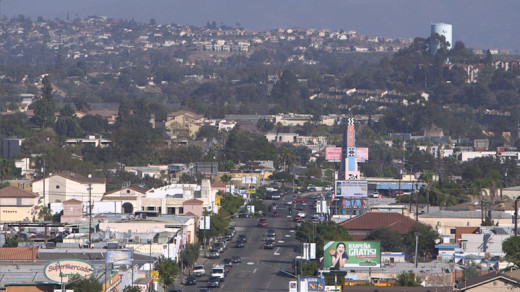Councilman David Alvarez calls it the Catch-22 of San Diego development.
Where development is economically viable, it isn’t politically viable. And where it’s politically viable, it isn’t economically viable.
In the end, you’ve got developers desperate to build in areas that don’t want it, and areas desperate for development that developers won’t touch.
“It’s difficult to engage the development community, because they obviously want to build where it’s profitable, but the places it’s profitable are more difficult politically,” Alvarez said.
His district feels one side of the dilemma. The city adopted a new community plan for greater Logan Heights last year. The planning group and Alvarez fought to increase development opportunities, even while communities throughout the city were fighting against new development.
Private developers aren’t biting. So far, the neighborhood has seen only publicly subsidized, low-income housing projects. The community has welcomed them, but they haven’t given way to private projects.
Meanwhile, developers and the city continue to duke it out with local opposition in other communities. In Mission Beach, Carmel Valley, Bay Park and Uptown, the market is there but the political support isn’t.
Alvarez and Councilwomen Myrtle Cole and Marti Emerald have a fix in mind.
It’s in some ways a return to the old way the city handled the problem.
San Diego used to rely on the state’s redevelopment program to drive investment in places where the private market wasn’t interested. It took property taxes collected in a given area and made them available for projects that would encourage more development nearby. That program died in 2012.
The state and cities all across it have grappled with the aftermath ever since, with cities struggling to improve disadvantaged areas.
Now, the state is giving cities back some of the property tax money generated from their former redevelopment areas through the Redevelopment Property Tax Trust Fund.
For 2016, the city is getting back $9.3 million of old redevelopment money. By 2021, the city’s independent budget analyst projects the annual payout to reach $23.7 million. Altogether, the city’s expected to receive $107.5 million from the state over the next five years.
Rather than send that money to the general fund – where it would help pay for all the city’s core services – Alvarez, Cole and Emerald suggested in a January memo to Mayor Kevin Faulconer to invest all that money in the city’s low-income neighborhoods.
“Using this revenue going forward to invest in San Diego’s economically disadvantaged communities, as originally intended allows areas in the greatest need of economic investment an opportunity to attract new commercial activity, which in turn creates new jobs and greater tax revenue for the city’s general fund,” the memo says.
It is not a full proposal yet. But the memo suggests the city direct the money generally toward areas eligible for federal Community Development Block Grants as a proxy for low-income neighborhoods that need the investment.
The Council members also mentioned using the funds on projects that would drive increased private investment, such as storefront improvement programs, business attraction efforts or waiving fees charged on private projects to make the neighborhood more attractive to builders.
The program wouldn’t just focus newfound revenue into under-invested communities. It would also focus public investment in the same places that the city is trying to incentivizing private investment: near transit stops.
Alvarez said the city should couple the move with cutting regulatory hurdles for new development in the same areas. The city could make further cuts to parking requirements in neighborhoods near transit, say, or make it easier to build high-quality “micro-apartments.”
“Anyone who isn’t thinking about how we can provide more housing, considering the state of San Diego right now, is not doing their job,” he said.
Even though the plan didn’t get much reaction when Alvarez, Cole and Emerald released their memo earlier this year, Alvarez said he’ll keep pushing it. He plans to introduce it through the economic development committee, which Cole chairs.
He’s already pursuing it on his own. In late February, Alvarez met with Civic San Diego’s executive leadership and board of directors to brief them on the idea.
Civic San Diego ran redevelopment in the city, back when it was the Centre City Development Corp. Alvarez wanted to see if the organization would be interested in administering the program for the city.
Reese Jarrett, president of Civic San Diego, said the idea fits the organization’s mission. But it would be a decision for the mayor and City Council.
“Certainly Civic San Diego would be encouraged to get additional funding sources to invest in underserved neighborhoods,” he said. “As additional funding for the work we’re charged to do, yes it absolutely would be a welcome decision by the mayor and Council. Absolutely.”
Councilman Chris Cate, who’s also on the city’s economic development committee, said he had some apprehensions about the plan.
For one, he said, targeting it to CDBG areas would leave out too much of the city.
“I understand the theory behind it, but you’d miss out on too many transit priority areas and jobs centers, like Kearny Mesa and Sorrento Valley,” he said. “Those are ripe opportunities for us to make improvements in those areas and fulfill our obligations to build near transit.”
Alvarez said he feels a sense of urgency to get the plan moving because like Cate, he’s worried the city won’t direct enough development into opportunities near transit.
The real estate market is hot, he said, and developers have money to spend. If the city doesn’t do enough to direct investment toward transit areas, the cycle will pass and development will happen elsewhere.
In short, Alvarez believes he’s determined the best course for combatting San Diego’s development Catch-22.
He’s decided it’s easier for the city to incentivize building in places where development is already politically viable than it is to wage political fights in the neighborhoods where developers already want to be.

